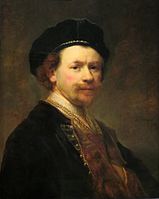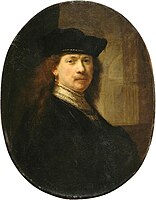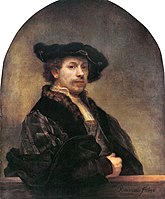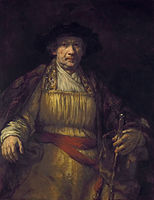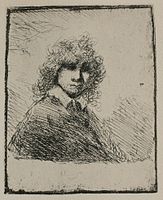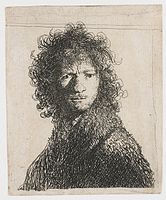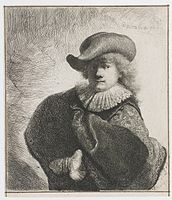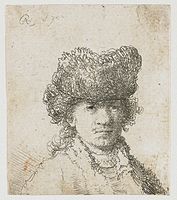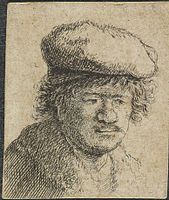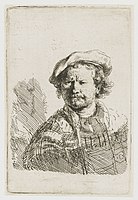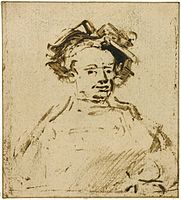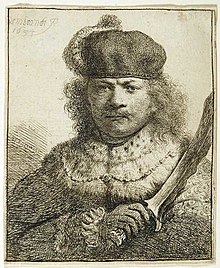

The dozens of self-portraits by Rembrandt were an important part of his oeuvre. Rembrandt created approaching one hundred self-portraits including over forty paintings, thirty-one etchings and about seven drawings; some remain uncertain as to the identity of either the subject (mostly etchings) or the artist (mostly paintings), or the definition of a portrait. [1]
Contents
This was an enormously high number for any artist up to that point, and around 10% of his oeuvre in both painting and etching. By comparison, the highly prolific Rubens only produced seven self-portrait paintings. [2] The self-portraits create a visual diary of the artist over a span of forty years. They were produced throughout his career at a fairly steady pace, [3] but there is a gradual shift between etchings, more numerous until the 1630s, to paintings, which are more common thereafter. However, there is a gap in paintings between 1645 and 1652. [4] The last three etchings date to 1648, [5] c. 1651, [6] and 1658, [7] whereas he was still painting portraits in 1669, the year he died at the age of 63. [8]
At one time about ninety paintings were counted as Rembrandt self-portraits, but it is now known that he had his students copy his own self-portraits as part of their training. [9] Modern scholarship, especially the Rembrandt Research Project, has reduced the autograph count to over forty paintings, as well as a few drawings and thirty-one etchings, which include many of the most remarkable images of the group. [3] The etchings are mostly informal, often playful tronies, studies of extreme facial expressions or portraits in what amounts to fancy dress; in several the clothes are the fashions of a century or more earlier. [10] In others he is pulling faces at himself. His oil paintings trace the progress from an uncertain young man, through the dapper and very successful portrait-painter of the 1630s, to the troubled but massively powerful portraits of his old age. Together they give a remarkably clear picture of the man, his appearance and his psychological make-up, as revealed by his richly weathered face. Kenneth Clark stated that Rembrandt is "with the possible exception of Van Gogh, the only artist who has made the self-portrait a major means of artistic self-expression, and he is absolutely the one who has turned self-portraiture into an autobiography." [11]
While the popular interpretation is that these images represent a personal and introspective journey, it is also the case that they were painted to satisfy a market for self-portraits by prominent artists. [12] Both paintings and etchings seem to have often been bought by collectors, [13] and while some of the etchings are very rare, others were printed in considerable numbers for the time. No self-portraits were listed in the famous 1656 inventory, [14] and only a handful of the paintings remained in the family after his death. [15]
Rembrandt's self-portraits were created by the artist looking at himself in a mirror, [16] and the paintings and drawings therefore reverse his actual features. In the etchings the printing process creates a reversed image, and the prints therefore show Rembrandt in the same orientation as he appeared to contemporaries. [17] This is one reason why the hands are usually omitted or "just cursorily described" in the paintings; they would be on the "wrong" side if painted from the mirror. [18] References to large mirrors occur at various points from the 1650s, and the later portraits include several showing him at a longer length than before; about 80 cm was the maximum height for a sheet of mirror glass technically possible in Rembrandt's lifetime. One may have been bought about 1652 and then sold in 1656 when he went bankrupt. In 1658 he asked his son Titus to arrange delivery of another one, which broke en route to his house. [16]


















